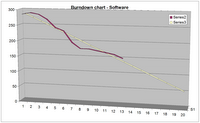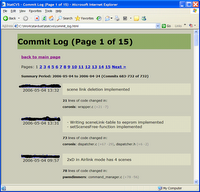I have been on a well deserved vacation for a week now. Yesterday I, for some werd reason (being on vacation and on Saturday), wanted to know what is going on in the project I'm involved with.
 I first took out the latest version of Excel sheet working as our backlog. I checked the Sprint burndown chart, fine, nothing to worry about. OK, what's been done? Let's see the Sprint backlog, OK, couple of features finishing nicely. Is there new stuff to do? Nope, Product backlog looks the same. I knew pretty much what's been done, as I had build reports from CruiseControl in my email, but I wanted a summary...
I first took out the latest version of Excel sheet working as our backlog. I checked the Sprint burndown chart, fine, nothing to worry about. OK, what's been done? Let's see the Sprint backlog, OK, couple of features finishing nicely. Is there new stuff to do? Nope, Product backlog looks the same. I knew pretty much what's been done, as I had build reports from CruiseControl in my email, but I wanted a summary... I hooked to CVS repository server, updated my sandbox, ran StatCVS and checked the commit history. Fine, I know that everything is going smoothly. I also know for a fact that in 2 weeks I'm going to see working prototypes with some test results in the next Sprint review. What I missed is a list of impediments to see what's going wrong, but we have not seen this meaningfull so far.
I hooked to CVS repository server, updated my sandbox, ran StatCVS and checked the commit history. Fine, I know that everything is going smoothly. I also know for a fact that in 2 weeks I'm going to see working prototypes with some test results in the next Sprint review. What I missed is a list of impediments to see what's going wrong, but we have not seen this meaningfull so far.This is the visibility I'm talking about. It just can not get any more transparent than that. I know exactly what is going on in my project. No emails, no phone calls or any other disturbance to the flow. Then again, I'm representative of technical developer/leader level.
I think traditional role of project manager consists of three components; leadership, management and administration. The bigger the project, the bigger the team and the bigger the organization - the bigger these individual responsibilities get. In a large organization the number of parallel projects may be high and backlog type reporting gives just way too much detail - too much visibility. The development abstraction layers described by Joel Spolsky apply also here. I blogged about them a while ago.
Schwaber explained an easy way of turning backlogs into Gannt charts in his book. Microsoft has already released a Scrum plugin for MS Project. This however for some reason does not satisfy me, there is some small piece missing before it makes sense to me. You have to be very careful when building up administrative or executive reporting mechanisms for an agile project. If you forget to watch out you may end up doing all the traditional reporting (Gannt, Earned Value, WBS, PERT, CPM, you name it...) AND agile reporting like backlogs from Scrum and/or parking lot reports from Feature-Driven Development. This means that you have lost the concept of traveling light that is so fundamental to agile philosophy.
1 comment:
What a great site, how do you build such a cool site, its excellent.
»
Post a Comment